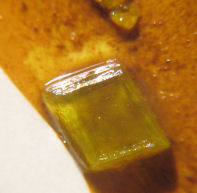Crystals
When a saturated solution of a compound is allowed to evaporate, crystals of the pure compound will fall out of solution. These images illustrate some examples of crystals we have made and the remarkable natural beauty of them.
Ammonium Chloride - NH4Cl
This is a crystallized layer of Ammonium Chloride, - NH4Cl - that formed on the top of the liquid in a beaker containing a saturated solution of the salt. We previously had evaporated much of the water in a 60° C water bath. When the liquid cooled to room temperature, 25° C, these crystals formed in a floating layer.
This also is Ammonium Chloride. These crystals are in the same beaker as those in the first image but this photo is taken from the side. The feathery crystals that are in the liquid contrast starkly white against the black background.
This is the same Ammonium Chloride, but a week later. These features formed as the crystal mass sat out in a low humidity environment undisturbed for several days. As the remaining liquid evaporated from the solid NH4Cl these structures that resemble cumulus clouds and have the color of powdered sugar formed.
Another view of the Ammonium Chloride.
Ammonium Nitrate - NH4NO3
This is crystallized Ammonium Nitrate. It was the mass that crystallized out from a saturated solution as it cooled. Unlike the Ammonium Chloride shown above, these crystals do not form structures that are nearly as interesting.
This is the same Ammonium Nitrate but a week later. This substance does not have the long needles that urea has. It looks much more like granulated sugar.
Urea (Carbamide) - (NH2)2CO
These are the needle-like crystals of Urea also know as Carbamide. They formed on the inside of the beaker where the liquid had been decanted to begin the recovery of the many crystals that had already formed. After those crystals were removed and the liquid poured off, these crystals formed on the glass after the remaining liquid evaporated.
This was a solid mass of Urea crystals that formed in the beaker after most of the liquid had been evaporated. It appeared as a solid compressed fibrous mass. The best way to describe it is that it looked like oriented strand board (OSB) but white and on a much smaller scale. Again, the long needle-like crystals are visible, but here they lay in layers atop one another, comprising a solid object.
And again we return to the beaker that was used to evaporate the Urea. This is a view of the bottom of the beaker. As in the other images, we can see the long thin crystals that have formed in great number.
This is the same Carbamide but a week later. This compound grew numerous coral-like extensions when left out in a dry air environment for a week.
Another view of the urea (carbamide) crystals. The solid base is not really as solid as it might appear. The multitude of needles lie in many directions but do not make an absolute solid layer. There are tiny gaps to be seen all over the mass.
And yet one more view of the carbamide.
Iron II Chloride) - Fe2Cl
This crystal of Iron II Chloride was formed from the evaporation of the liquid after leaving an iron nail in a concentrated hydrochloric acid solution for a few days. The liquid was rather brownish, but the crystals that formed were greenish. They became redder upon oxidation. The crystal appears rhombic and looks like a stack of plates. The stack isn't straight up, however, it "leans" as it increases in height. Also we note that the top surface is not flat, but looks like it has a rim around the periphery.

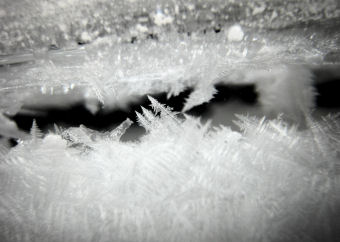
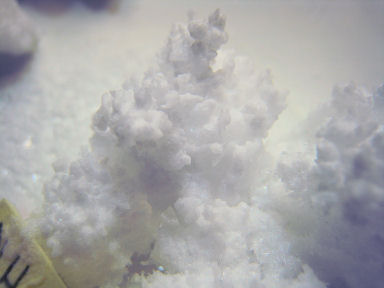
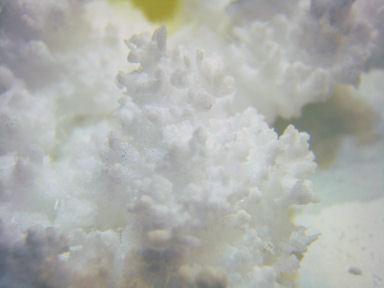
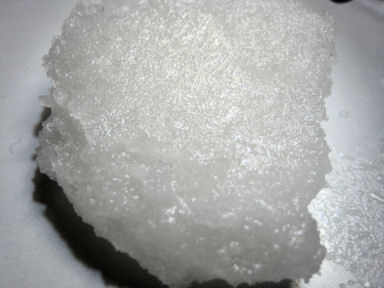
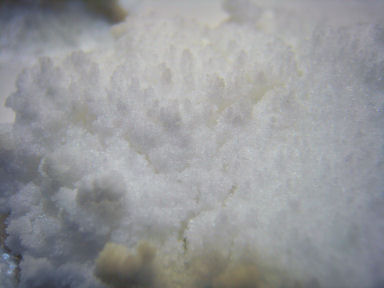
2co/(nh2)2co_xtal1_sm.jpg)
2co/(nh2)2co_xtal2_sm.jpg)
2co/(nh2)co_xtal3_sm.jpg)
2co/urea_112211_1_sm.jpg)
2co/urea_112211_2_sm.jpg)
2co/urea_112211_3_sm.jpg)
